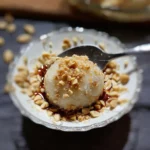There are certain desserts that feel like a hug from the past. For me, that dessert is Almond Jello. I remember it vividly from countless family dim sum lunches—a pristine, wobbly white cube swimming in a light syrup with a kaleidoscope of fruit cocktail. It was always the perfect, refreshing end to a meal of savory, rich dumplings and buns. For years, I assumed it was a complex restaurant secret, something too finicky to recreate at home. When I finally tried, I was shocked. Not only was it ridiculously easy, but making it from scratch allowed me to elevate it. I could control the sweetness, the intensity of the almond flavor, and swap the classic canned fruit for fresh, vibrant alternatives. The first time I served my homemade version to my family, sliced into perfect diamonds and topped with fresh mango and lychees, the reaction was pure delight. It was familiar yet better, a nostalgic treat given a modern, fresh-faced makeover. It’s now my go-to dessert for potlucks and dinner parties, a deceptively simple showstopper that never fails to impress.
The Ultimate Homemade Almond Jello: A Refreshing Classic
This recipe breaks down the process of making silky, fragrant, and perfectly set almond jello, also known by its traditional name, Annin Tofu. We will explore the simple science behind getting that perfect wobble and the endless possibilities for serving this elegant dessert.
Complete Ingredients List
The beauty of this recipe lies in its simplicity. You only need a handful of core ingredients to create this masterpiece.
- 2 cups Whole Milk: For the creamiest, richest texture. You can substitute with 2% milk for a lighter version, or a plant-based milk for a vegan alternative (see FAQ for more details).
- 2 cups Water: This balances the richness of the milk, keeping the dessert light and refreshing.
- 1/2 cup to 3/4 cup Granulated Sugar: Adjust according to your preference. 1/2 cup yields a mildly sweet jello, perfect if you’re serving it with a sweet syrup or fruit. 3/4 cup results in a sweeter dessert that’s delicious on its own.
- 2 teaspoons Agar-Agar Powder: This is the most crucial ingredient. Agar-agar is a vegetarian gelling agent derived from seaweed. It creates a firmer, more heat-stable jello than gelatin. Do not substitute with gelatin without significant changes to the recipe. Ensure you are using agar-agar powder, not flakes or bars, as the measurements differ.
- 1.5 to 2 teaspoons Pure Almond Extract: The soul of the dessert. The quality of your extract matters immensely. Use pure almond extract for the best, most authentic flavor. Start with 1.5 teaspoons, taste the liquid mixture, and add the final 1/2 teaspoon if you desire a stronger almond presence.
- Optional Toppings: Canned fruit cocktail (drained), fresh fruits (diced mango, lychees, strawberries, kiwi), simple syrup, or osmanthus syrup.
Step-by-Step Instructions
Follow these instructions carefully to ensure a smooth, perfectly set jello without any lumps.
Step 1: Bloom the Agar-Agar
- In a medium-sized saucepan, pour in the 2 cups of cold water.
- Sprinkle the 2 teaspoons of agar-agar powder evenly over the surface of the water.
- Let it sit for 5-10 minutes without stirring. This step, known as “blooming,” allows the agar-agar to soften and absorb the water, which is essential for preventing clumps when you heat it. You’ll see the powder become hydrated and slightly translucent.
Step 2: Dissolve the Sugar and Agar-Agar
- Place the saucepan on the stove over medium heat.
- Begin whisking continuously. As the water heats up, the bloomed agar-agar will start to dissolve.
- Once the mixture is warm (but not yet simmering), pour in the sugar. Continue to whisk until both the sugar and the agar-agar are completely dissolved. The liquid should look clear, not grainy. Scrape the bottom and sides of the pan with your whisk to ensure no granules are stuck.
Step 3: The Crucial Simmer
- Bring the mixture to a gentle simmer. This is the activation step for the agar-agar. It needs to reach a temperature of about 185-195°F (85-90°C) to fully activate its gelling properties.
- Let it simmer gently for 2 full minutes, still whisking occasionally. Do not let it come to a hard, rolling boil. A steady, gentle simmer is all you need. If you skip this step or don’t heat it long enough, your jello may not set properly.
Step 4: Incorporate the Milk and Flavoring
- Turn the heat down to low. Slowly pour the 2 cups of milk into the saucepan, whisking constantly to combine everything smoothly.
- Heat the mixture gently for another minute until it is uniformly hot, but do not let it boil after adding the milk, as this can cause the milk to curdle or separate.
- Remove the saucepan from the heat completely.
- Stir in the almond extract. Start with 1.5 teaspoons, stir, and if you have a clean spoon, you can taste the liquid to see if you’d like it more intensely almond-flavored before adding more.
Step 5: Strain and Chill
- Position a fine-mesh sieve over a heat-proof 8×8 inch glass or ceramic dish (a loaf pan also works well).
- Carefully pour the hot liquid mixture through the sieve into the dish. This is a professional touch that guarantees an ultra-silky final product by catching any tiny, undissolved bits of agar-agar or milk solids.
- Let the dish cool on the countertop for about 20-30 minutes, or until it is no longer steaming.
- Once cooled to near room temperature, carefully cover the dish with plastic wrap (try not to let the wrap touch the surface of the liquid) and transfer it to the refrigerator.
- Chill for at least 4 hours, or until completely firm. Overnight is even better. Unlike gelatin, agar-agar will begin to set at room temperature, but chilling makes it firm, cold, and refreshing.
Step 6: Cut and Serve
- Once fully chilled and firm, run a thin knife around the edges of the dish to loosen the jello.
- You can either cut the jello directly in the dish into cubes or diamonds, or you can carefully invert the entire block onto a clean cutting board and then slice it.
- Serve immediately with your favorite toppings.
The Cultural Significance: What is Annin Tofu?
While we call it Almond Jello, its traditional name is Annin Tofu (杏仁豆腐), which translates to “apricot kernel tofu.” This name reveals its fascinating history. The dessert did not originally get its almond-like flavor from almonds at all, but from Southern Chinese apricot kernels (xìngrén, 杏仁). These kernels, when ground and cooked with a gelling agent, release a flavor remarkably similar to almonds.
The “tofu” part of the name doesn’t refer to the presence of soy, but rather to its appearance and texture—a soft, silky, white block, much like silken tofu.
Over time, as the dessert’s popularity spread, pure almond extract became a much easier and more accessible way to achieve the signature flavor, especially outside of Asia. Today, almost all modern recipes, both in restaurants and homes, use almond extract. However, understanding its origin as “apricot kernel tofu” adds a wonderful layer of appreciation for this simple yet profound dessert that has graced tables for generations as a symbol of light, cooling refreshment.
Nutrition Facts
- Servings: Makes 8-10 servings
- Calories per serving: Approximately 110-140 kcal (This is an estimate based on using whole milk and 1/2 cup of sugar. The final count will vary based on your choice of milk, amount of sugar, and toppings.)
This is a relatively light dessert, making it a wonderful, guilt-free treat after a heavy meal.
Preparation Time
- Active Time: 15 minutes
- Chilling Time: 4 hours (minimum)
- Total Time: 4 hours and 15 minutes
How to Serve Your Almond Jello
The presentation is half the fun! Here are some classic and creative ways to serve your homemade almond jello, catering to different tastes and occasions.
- The Classic Dim Sum Style:
- This is the most nostalgic and common presentation.
- Simply spoon the cut almond jello cubes into a small bowl.
- Top with a generous spoonful of canned fruit cocktail, including some of the light syrup from the can. The combination of peaches, pears, grapes, and cherries is iconic.
- The Fresh & Fruity Style:
- For a more modern and vibrant take, use fresh fruit. This is perfect for summer.
- Diced Mango: The sweet, tropical flavor of fresh mango is a perfect match.
- Fresh Lychees: Peeled and pitted lychees offer a floral sweetness and unique texture.
- Mixed Berries: A combination of strawberries, blueberries, and raspberries adds a beautiful color contrast and a touch of tartness.
- Diced Kiwi or Mandarin Oranges: For a bright, citrusy kick.
- The Elegant & Aromatic Style:
- This presentation is perfect for a more formal dinner party.
- Make a simple syrup by dissolving 1/2 cup of sugar in 1 cup of water over heat. Let it cool completely.
- For an even more sophisticated flavor, create an osmanthus syrup. Steep dried osmanthus flowers in your simple syrup for a delicate, floral, apricot-like aroma.
- Serve the almond jello cubes in a pool of the chilled syrup and garnish with a few goji berries and a sprig of mint.
- The Modern & Fun Style:
- Take inspiration from bubble tea shops.
- Serve the almond jello cubes with chewy boba pearls.
- Drizzle with a brown sugar syrup or a drizzle of condensed milk for a richer, more decadent dessert.
- This style adds a fun, textural contrast that kids and adults will love.
Additional Tips for Perfect Almond Jello Every Time
- Respect the Agar-Agar: Agar-agar is not gelatin. It’s a seaweed-based gelling agent that sets much more firmly and can withstand warmer temperatures. You cannot do a 1:1 substitution with gelatin. If you only have gelatin, you will need to find a different recipe specifically formulated for it, as the blooming and setting processes are completely different.
- Master the “Bloom and Boil” Technique: The two most common failures with almond jello are a grainy texture or a jello that doesn’t set. Both are solved by treating the agar-agar correctly. First, bloom it in cold liquid to hydrate it. Second, ensure you bring it to a sustained, gentle simmer for at least 2 minutes to fully activate it. Don’t rush this step!
- Strain for Ultimate Silkiness: Don’t skip the straining step. It takes 30 seconds and is the difference between a good homemade jello and a great, restaurant-quality one. It catches any stubborn, undissolved particles, ensuring every bite is perfectly smooth and silky on the tongue.
- The Quality of Your Extract Matters: Since almond is the star flavor, using a high-quality, pure almond extract will yield a far superior taste than an artificial or imitation one. Imitation extracts can sometimes have a harsh, chemical-like aftertaste, while pure extract has a cleaner, more aromatic, and nutty profile.
- Patience is a Virtue (Especially for Cutting): For beautifully clean, sharp-edged cubes or diamonds, your jello needs to be completely chilled and firm. Trying to cut it too early will result in sloppy edges. Chilling it overnight is your best bet. To get extra clean cuts, you can dip your knife in hot water and wipe it clean between slices.
Frequently Asked Questions (FAQ)
1. Can I make this recipe vegan?
Yes, absolutely! The base recipe is easily made vegan. Simply substitute the whole milk with your favorite plant-based milk. For the best results, use a creamy, full-fat plant milk like full-fat oat milk, soy milk, or canned coconut milk (the beverage kind, not the thick cream). Almond milk also works, but the final jello will be slightly less creamy and rich. The rest of the ingredients (sugar, water, agar-agar, almond extract) are already vegan.
2. Why is my almond jello grainy or lumpy?
A grainy texture is almost always due to the agar-agar not dissolving completely. This can happen for two reasons: 1) You didn’t “bloom” the agar-agar in cold water before heating, causing it to clump up instantly in hot water. 2) You didn’t bring the mixture to a high enough temperature or hold the simmer for long enough (at least 2 minutes) to fully dissolve and activate the agar-agar powder.
3. Can I use almond milk instead of regular milk? Will it taste more “almond-y”?
You can definitely use unsweetened almond milk. However, it’s a common misconception that this will boost the almond flavor. The dominant flavor comes from the potent almond extract, not the milk itself. Using almond milk will result in a jello that is slightly less creamy and white than one made with dairy or oat milk, but it will still be delicious. The key to the flavor is in the extract.
4. How do I store homemade almond jello, and how long does it last?
Store the almond jello in an airtight container in the refrigerator. If you store the entire block, keep it in its setting dish and cover it tightly with plastic wrap. If you’ve already cut it, place the cubes in a container. It’s best to store it without toppings. It will stay fresh and delicious for up to 5 days. After a few days, it may begin to weep a little water, which is normal for agar-based gels.
5. My jello didn’t set! What went wrong?
This is the most frustrating outcome, and it almost always comes down to the agar-agar activation. Here are the likely culprits:
- The simmer wasn’t long or hot enough: Agar-agar needs to reach about 185°F (85°C) and be held there for a couple of minutes to work.
- Incorrect measurement: Using too little agar-agar powder for the amount of liquid will result in a soft or liquid mixture.
- Old agar-agar: Like any pantry staple, agar-agar can lose its potency over time. If your powder is very old, it might not gel as effectively.
- Using flakes or bars instead of powder: Agar-agar flakes and bars are much less concentrated than the powder and require different measurements and longer boiling times. This recipe is specifically calibrated for agar-agar powder.

Homemade Almond Jello recipe
Ingredients
-
2 cups Whole Milk: For the creamiest, richest texture. You can substitute with 2% milk for a lighter version, or a plant-based milk for a vegan alternative (see FAQ for more details).
-
2 cups Water: This balances the richness of the milk, keeping the dessert light and refreshing.
-
1/2 cup to 3/4 cup Granulated Sugar: Adjust according to your preference. 1/2 cup yields a mildly sweet jello, perfect if you’re serving it with a sweet syrup or fruit. 3/4 cup results in a sweeter dessert that’s delicious on its own.
-
2 teaspoons Agar-Agar Powder: This is the most crucial ingredient. Agar-agar is a vegetarian gelling agent derived from seaweed. It creates a firmer, more heat-stable jello than gelatin. Do not substitute with gelatin without significant changes to the recipe. Ensure you are using agar-agar powder, not flakes or bars, as the measurements differ.
-
1.5 to 2 teaspoons Pure Almond Extract: The soul of the dessert. The quality of your extract matters immensely. Use pure almond extract for the best, most authentic flavor. Start with 1.5 teaspoons, taste the liquid mixture, and add the final 1/2 teaspoon if you desire a stronger almond presence.
-
Optional Toppings: Canned fruit cocktail (drained), fresh fruits (diced mango, lychees, strawberries, kiwi), simple syrup, or osmanthus syrup.
Instructions
Step 1: Bloom the Agar-Agar
-
In a medium-sized saucepan, pour in the 2 cups of cold water.
-
Sprinkle the 2 teaspoons of agar-agar powder evenly over the surface of the water.
-
Let it sit for 5-10 minutes without stirring. This step, known as “blooming,” allows the agar-agar to soften and absorb the water, which is essential for preventing clumps when you heat it. You’ll see the powder become hydrated and slightly translucent.
Step 2: Dissolve the Sugar and Agar-Agar
-
Place the saucepan on the stove over medium heat.
-
Begin whisking continuously. As the water heats up, the bloomed agar-agar will start to dissolve.
-
Once the mixture is warm (but not yet simmering), pour in the sugar. Continue to whisk until both the sugar and the agar-agar are completely dissolved. The liquid should look clear, not grainy. Scrape the bottom and sides of the pan with your whisk to ensure no granules are stuck.
Step 3: The Crucial Simmer
-
Bring the mixture to a gentle simmer. This is the activation step for the agar-agar. It needs to reach a temperature of about 185-195°F (85-90°C) to fully activate its gelling properties.
-
Let it simmer gently for 2 full minutes, still whisking occasionally. Do not let it come to a hard, rolling boil. A steady, gentle simmer is all you need. If you skip this step or don’t heat it long enough, your jello may not set properly.
Step 4: Incorporate the Milk and Flavoring
-
Turn the heat down to low. Slowly pour the 2 cups of milk into the saucepan, whisking constantly to combine everything smoothly.
-
Heat the mixture gently for another minute until it is uniformly hot, but do not let it boil after adding the milk, as this can cause the milk to curdle or separate.
-
Remove the saucepan from the heat completely.
-
Stir in the almond extract. Start with 1.5 teaspoons, stir, and if you have a clean spoon, you can taste the liquid to see if you’d like it more intensely almond-flavored before adding more.
Step 5: Strain and Chill
-
Position a fine-mesh sieve over a heat-proof 8×8 inch glass or ceramic dish (a loaf pan also works well).
-
Carefully pour the hot liquid mixture through the sieve into the dish. This is a professional touch that guarantees an ultra-silky final product by catching any tiny, undissolved bits of agar-agar or milk solids.
-
Let the dish cool on the countertop for about 20-30 minutes, or until it is no longer steaming.
-
Once cooled to near room temperature, carefully cover the dish with plastic wrap (try not to let the wrap touch the surface of the liquid) and transfer it to the refrigerator.
-
Chill for at least 4 hours, or until completely firm. Overnight is even better. Unlike gelatin, agar-agar will begin to set at room temperature, but chilling makes it firm, cold, and refreshing.
Step 6: Cut and Serve
-
Once fully chilled and firm, run a thin knife around the edges of the dish to loosen the jello.
-
You can either cut the jello directly in the dish into cubes or diamonds, or you can carefully invert the entire block onto a clean cutting board and then slice it.
-
Serve immediately with your favorite toppings.
Nutrition
- Serving Size: one normal portion
- Calories: 110-140 kcal






